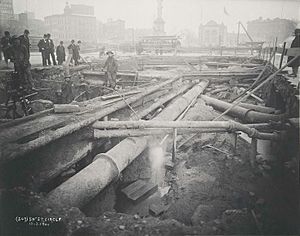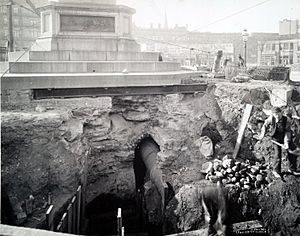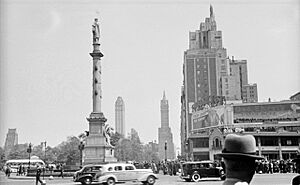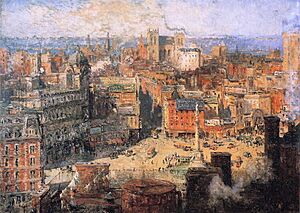Columbus Circle facts for kids
Quick facts for kids
Columbus Circle
|
|
|---|---|
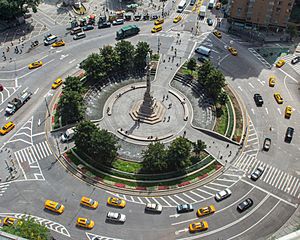
Columbus Circle in Manhattan
|
|
| Country | |
| State | |
| City | New York City |
| Borough | Manhattan |
| Community District | Manhattan 4, Manhattan 7 |
| Time zone | UTC−05:00 (Eastern) |
| • Summer (DST) | UTC−04:00 (EDT) |
| ZIP Code |
10019
|
| Area codes | 212, 332, 646, and 917 |
| Boundaries | 61st Street, Ninth Avenue, 57th Street, Seventh Avenue |
| Subway services | 1, A, B, C, and D train at 59th Street–Columbus Circle station |
| Bus routes | M5, M7, M10, M20, M104 |
| Historical features | Columbus Monument USS Maine National Monument |
Columbus Circle is a busy traffic circle and intersection in Manhattan, one of New York City's boroughs. It's located where Eighth Avenue, Broadway, Central Park South (West 59th Street), and Central Park West meet. This circle is right at the southwest corner of Central Park.
Columbus Circle is super important because it's the official starting point for measuring highway distances from New York City. It's also the center of a special 25-mile travel zone for people with certain types of visas.
The circle gets its name from the monument of Christopher Columbus that stands right in its middle. This monument is so important that it's listed on the National Register of Historic Places. The name "Columbus Circle" also refers to the neighborhood around the circle, stretching a few blocks in every direction. Nearby areas include Hell's Kitchen to the southwest, the Theater District to the southeast, and Lincoln Square to the northwest.
Contents
History of Columbus Circle
The idea for Columbus Circle came from Frederick Law Olmsted in 1857. He designed it as part of his plan for Central Park. The circle is next to the Merchant's Gate, one of the park's main entrances. Other similar plazas were planned for the other corners of Central Park.
Work to clear the land for the circle began in 1868. The actual circle was approved two years later. The Columbus Monument was placed in the center of the circle in 1892. At first, people just called it "The Circle." After the monument was put in, it became known as "Columbus Circle."
Subway Construction and Traffic Changes
Around 1901, the first subway line was being built. This meant digging up the circle, and the Columbus monument had to be put on temporary wooden supports! The 59th Street–Columbus Circle subway station was built underneath. This subway line opened on October 27, 1904.
Later, in 1925, another subway line was built under Columbus Circle. Workers had to be very careful not to disturb the existing subway line or the monument above. This second line opened in 1932, making Columbus Circle a major subway hub.
How Traffic Flowed
In 1905, a businessman named William Phelps Eno changed how traffic moved around the circle. Before his plan, cars went in both directions, causing many accidents. Eno made traffic go only one way, counterclockwise. This was the first true one-way traffic circle anywhere!
However, this plan didn't work perfectly. By 1929, there were too many cars, and streetcars still went in different directions, causing problems. Police officers had to manage 58,000 cars every 12 hours! So, in November 1929, the one-way traffic rule was removed, and cars could go in both directions again.
Modern Updates
Even with the changes, traffic was still a problem. In 1941, city engineers planned to redesign the circle again. They wanted to separate "local" and "express" traffic. This plan was put on hold because of World War II.
Work finally began in 1949. The old streetcar tracks were removed, and a new traffic light system was designed. The project was finished in December 1949. More changes happened in the 1950s to prepare for the New York Coliseum, a large event venue, being built nearby.
By the late 1900s, Columbus Circle was still difficult for people to cross. In 1987, a new design was planned. The circle was updated in 1991–1992 for the 500th anniversary of Columbus's arrival in the Americas.
In 1998, the one-way, counterclockwise traffic flow was brought back. A big renovation started in 2003 and finished in 2005. This project added a beautiful new water fountain with 99 jets that change their force and speed. It also added benches and new plants. This redesign won awards for its great look and function.
The Columbus Monument

The Columbus Monument is a tall column in the center of Columbus Circle. It stands about 76 feet (23 meters) high. On top, there's a 14-foot (4-meter) marble statue of Christopher Columbus. This statue sits on a granite column, which is on a four-step granite base.
Italian sculptor Gaetano Russo created the monument. It was put in place in 1892. The monument is so important that it's listed on the National Register of Historic Places.
What's Around the Circle?
The streets that spread out from Columbus Circle divide the area into five different parts.
In the early 1900s, a magazine publisher named William Randolph Hearst bought a lot of land around Columbus Circle. He wanted to build a huge headquarters for his company there. He believed this area would become the city's next big entertainment spot. The Hearst Tower is the only part of his big plan that was actually built.
West Side Buildings
To the west of the circle is a very large block of buildings. This area used to have an older neighborhood and two theaters.
From 1954 to 1956, the New York Coliseum was built here. It was a major event venue for New York City for many years. The Coliseum was torn down in 2000.
Since 2003, the site has been home to the Deutsche Bank Center (originally called Time Warner Center). This building has two tall towers, each 53 stories high. It also includes the Shops at Columbus Circle mall, Jazz at Lincoln Center, the New York City studios for CNN, and the Mandarin Oriental, New York hotel. The mall has famous restaurants like Per Se and Masa.
North Side Buildings
The north side of Columbus Circle is bordered by Broadway, Central Park West, and 61st Street. In 1911, William Randolph Hearst bought this block. A building was put up in 1914, but a planned 30-story tower was never built.
The 44-story Gulf and Western Building was finished on this site around 1969. In 1994, Donald Trump decided to turn it into a hotel and apartment building. It was completely renovated from 1995 to 1997, becoming the Trump International Hotel and Tower. A large steel globe was added outside the building during this renovation.
Northeast Side: Central Park and a Monument
On the northeast side is the Merchant's Gate entrance to Central Park. This area is known for the USS Maine National Monument. This monument was designed by Harold Van Buren Magonigle and sculpted by Attilio Piccirilli and Charles Keck. It's a beautiful marble and bronze structure dedicated in 1913.
The monument honors sailors who died on the battleship USS Maine. Its explosion in 1898 in Havana harbor led to the Spanish-American War.
South Side Buildings
The Museum of Arts and Design is located on the south side of the circle at 2 Columbus Circle. This building was originally built in 1960 as an art gallery. After some debate about its future, it was renovated and became the Museum of Arts and Design in 2008.
Southeast Side Buildings
Several buildings are on the block bordering the southeast part of the circle. 240 Central Park South is a modern apartment building with balconies, built between 1939 and 1940. It's a city landmark and has many apartments, some with roof gardens.
Next to it is the Gainsborough Studios, built in 1907–1908. It was designed as cooperative housing for artists. The building has a bust of the English painter Thomas Gainsborough and unique tile murals. It is also a New York City landmark.
East of these buildings is 220 Central Park South, a very tall 70-story residential skyscraper finished in 2019. It contains some of the most expensive homes ever sold in New York City.
On 58th Street, there are two more city landmarks: the Helen Miller Gould Stable and the firehouse of Engine Company 23. The stable, built in 1902–1903, was for a wealthy person's horses. The firehouse, built in 1905–1906, is still an active fire station today.
Other Buildings: 3, 4, 5, and 6 Columbus Circle
These numbers refer to four buildings on the south side of 58th Street.
- 5 Columbus Circle (also known as 1790 Broadway) is a 20-story tower built in 1912. It was originally the headquarters for a rubber company. Today, it has part of a Nordstrom store.
- 3 Columbus Circle (also 1775 Broadway) is a 26-story tower. The first three floors were built in 1923, and the top 23 stories were added in 1927–1928. It used to be the headquarters for General Motors. Today, it houses several companies and a Nordstrom annex.
- 4 Columbus Circle is an eight-story building built in the late 1980s. It has a furniture company on its upper floors and stores like Duane Reade and Starbucks on the ground floor.
- 6 Columbus Circle is a 12-floor boutique hotel with 88 rooms. A much taller tower is planned for this site in the future.
Getting Around Columbus Circle
Columbus Circle is a major transportation hub.
- The M5, M7, M10, M20, M104 buses all serve the circle.
- Under the circle is the New York City Subway's 59th Street–Columbus Circle station, which is served by the 1, 2, A, B, C, and D train subway lines.
Why Columbus Circle is Important
A Central Point
Columbus Circle is the traditional "zero-mile point" for New York City. This means that all official city distances are measured from here. For example, some maps used to show areas within 25 or 75 miles of Columbus Circle.
Also, the travel area for people with certain visas (like those going to the United Nations headquarters) is limited to a 25-mile radius around Columbus Circle. This same circle also defines the city's "film zone" for local movie unions.
A Place for Speeches
In the early to mid-1900s, Columbus Circle became famous as a place where people would give public speeches. It was a spot for people to share their ideas, similar to Speakers' Corner in London. It was sometimes seen as a symbol of American freedom of speech.
In Movies and TV
Columbus Circle has appeared in many movies and TV shows:
- In the 1954 romantic comedy It Should Happen to You, a character rents a huge billboard overlooking Columbus Circle.
- The USS Maine Memorial was featured in the 1976 movie Taxi Driver.
- Columbus Circle was seen in the 1984 movie Ghostbusters when the Stay Puft Marshmallow Man appears there.
- Starting in season 6 of the TV show The Venture Bros., the Venture family moves to a skyscraper located on Columbus Circle.
Images for kids
-
The USS Maine National Monument at the Merchant's Gate entrance to Central Park
-
220 Central Park South (2018) rises above 240 Central Park South (1939)
-
U.S. Rubber Headquarters at 1790 Broadway in 2010
See also
 In Spanish: Columbus Circle para niños
In Spanish: Columbus Circle para niños


